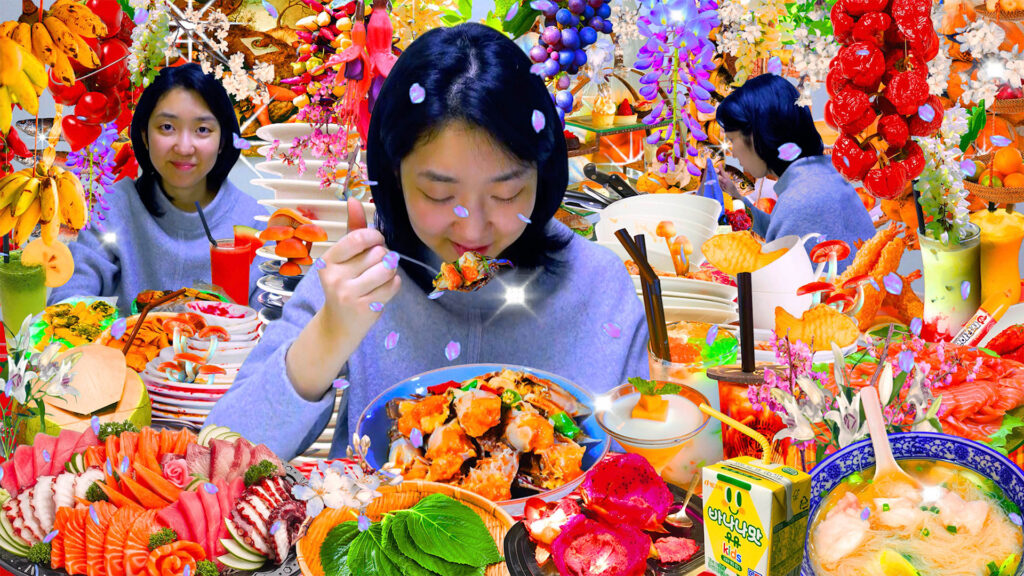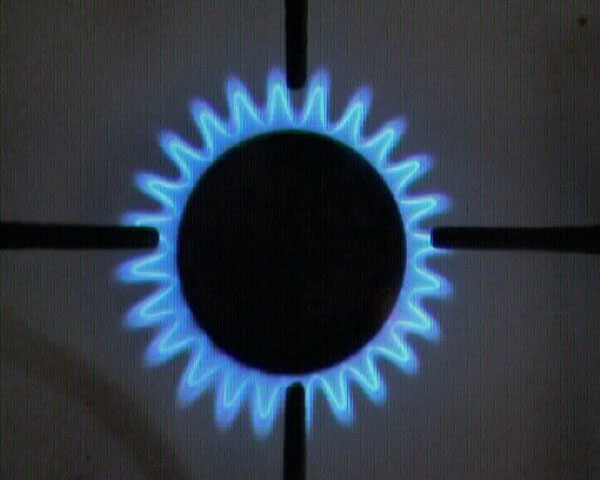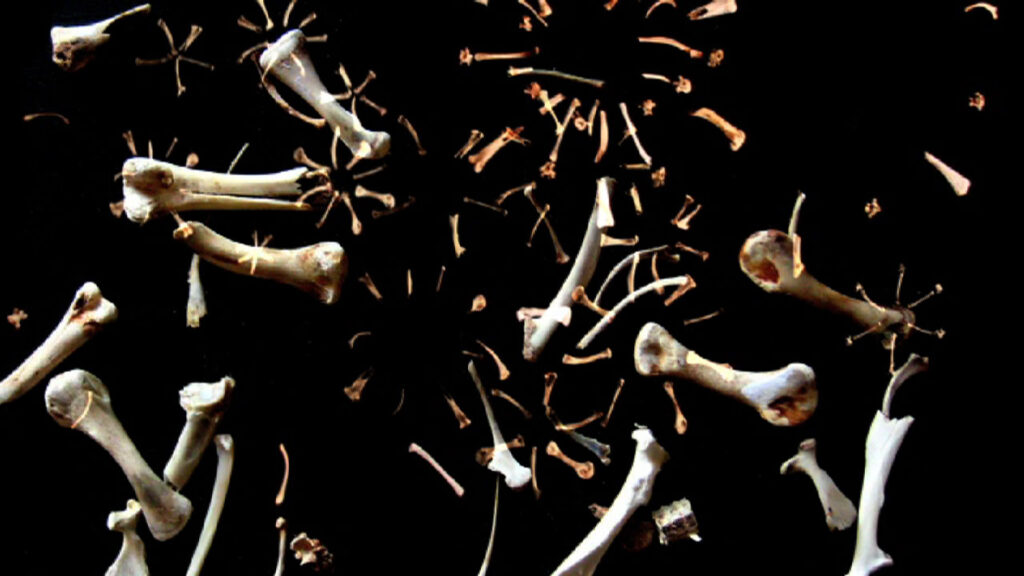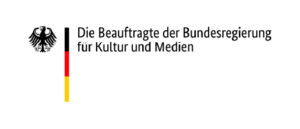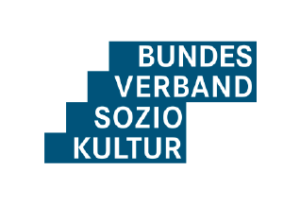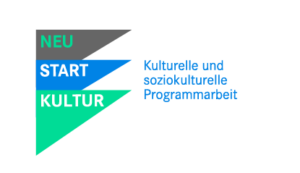- Dmitry Bulnygin
- Lia Anna Hennig
- Paul Horn & Harald Hund
- , Alexandra Mitlyanskaya
- Gyonyoung Yoon
- Ezra Wube
Feast of Food | Video Window cooperation with Videocity/Basel
In cooperation with Videocity/Basel “Festival of Food”, curated by Elisabeth Höller, Christina Böckler, Luise Hoyer and the Videocity team around Dr. Andrea Domesle, everything revolves around the instrumentalization of beautiful appearances.
In cooperation with Videocity from Basel, we are showing the video program Ein Fest des Essens/Feast of Food in the public space in front of the ESSZIMMER – suitable for the season and the upcoming holidays, the video window brings some light into the dark:
from December 4th, 2022, every day, 4pm – 8pm
Eating and drinking are an important part of a festival and leisure culture. This becomes particularly clear at the end of the year: food is used to instrumentalize a beautiful appearance. This is what the contribution of the international network Videocity, led by curator Dr. Andrea Domesle.
With climate change and wars, the difference between those who suffer from hunger and those who have overabundance is becoming ever clearer. Six video artists will be presented. They come from Ethiopia, Germany, England, Austria, Russia and South Korea. The videos make it clear how strongly origin and society affect the depiction of food intake.
The works were created between 2005 and 2020 and thus in different systems. It all starts out colourful, glitteringly tempting or even childishly inexperienced, with the bitter end, in which one of the bites gets stuck in the throat, set in sooner or later.
curated by:
Elisabeth Höller, Christina Böckler und Luise Hoyer
artists:
Dmitry Bulnygin, Lia Anna Hennig, Paul Horn & Harald Hund, Alexandra Mitlyanskaya, Gyonyoung Yoon, Ezra Wube.

Dmitry Bulnygin | „Spring (Salut)“ (2010) 3:40 Min., with audio
Year after year, on 31st December, exactly at the midnight, people all over the Western world celebrate the New Year’s Eve. It is a new beginning. A new hope. A new promise, to do everything better. And it all goes by, like the fireworks on the night sky.
The dark wings of the Dmitry Bulnygin´s ‘gastronomic fireworks’ just underline the transience of the moment.
For 3 minutes 40 seconds we look at the monitor. It is an enchanted place. All the deliciousness that has been so carefully prepared for the ‘night of the new beginnings’, is flying in the sky. Sausages, salads, fish, vegetables, apple cores, broken champagne bottles. Everything is eaten, cracked and crashed. And here we go again, the ‘new’ year is not new anymore.
Isn’t it a curious thought – each newness becomes old, the moment we realise it?
So many people look up in the sky, admiring the glimmer of the bright lights. The same ones look down, a few minutes later.
The sweet euphoria is over.
The collective excitement is over.
But each finale means a new beginning.
Text: Inna Humeniuk
Lia Anna Hennig | „Sweet Pieces and the Sound of the Birth of a Fish“ (2005) 5:04 Min., with audio
In Lia Anna Hennig’s work, food is the main subject. The artist uses it as the material for the individual video works, mostly in a surreal and provocative way. In her video Sweet Pieces and the Sound of the Birth of a Fish from 2005, for example, she uses the stop-motion technique to put a fish together – piece by piece – in a five-minute video. This film technique generates the illusion of movement by stringing together individual images of still motifs.
The viewer looks down onto a bright surface on which the fragments of the fish magically merge into one. The ghostly feel is intensified by the individual fragments moving over and over again above the static image frame, only to finally accumulate in the centre of the picture all by themselves. The shadowless continuous lighting also contributes to this impression. The reddish colouring alone makes the fish parts stand out from the background.
At the beginning of the video the emerging creature reminds us more of a surreal monster than a fish. Little by little, all the body parts return to their place, as if they wanted to return to their original function. The first sequence shows a small, almost transparent bubble, reminiscent of fish eggs. In the following frame a fisheye appears, moving around the screen and finally finding its place in the middle. The body gradually forms around the eye, first it’s the skeleton and muscles and later the organs. Finally, the fish skin closes off the insides of the fish and its fins are formed. Once it is fully assembled, it ‘swims’ out of the picture full of movement, but not without returning several more times.
At first, the wondrous sounds that are heard during the assembly of the fish cause astonishment. Only on closer listening can the words ‘blub’ or ‘gluck’ be heard, along with other sounds. ‘[…] The sound consists of a collage of sounds, all of which were made and recorded by me’ (Lia Anna Hennig to Leoni Reiber, 25.08.2020). The individual changes to the state of the fish are accompanied by sounds, thus emphasising every moment of the transformation.
The technique of the soundtrack makes it clear that Lia Anna Hennig refers to older film techniques. In silent film, too, the sound was composed to follow the image – a choreography was created with the image sequences.
The artist herself gives little information about the video and thus leaves much room for interpretation. The fish as a Christian symbol has a recurring place in art history. Additionally to the early Christian works in which the fish symbolises baptism and thus the admission to Christianity, it can also be seen in the still life genre of painting. Today the Christian association of the fish has faded away, bringing its existence as food to the foreground.
Text: Regina Heinzelmann
Harald Hund und Paul Horn | „Mouse Palace“ (2010) 10:24 Min., with audio
The films by Paul Horn and Harald Hund record moments of slapstick, absurdity and irony of everyday life, in which the laws of physics and gravitation as well as proportions are overturned, bringing the fragility of our reality to the viewers’ attention. Situations from real life, presented as fictional scenes, negotiate traditional life models in which unusual events come to light.
For the work “Mouse Palace”, a flat was built on a scale of 1:10 from food. Based on the model of an existing flat, it was made available for mice as their living space. The film is the continuation of a cinematic series on housing by Horn and Hund, which includes “Tomato Heads”, “Dropping Furniture” and “Apnoea”. In “Tomato Heads” the protagonists are filmed upside down and try to hold on to familiar bodily rituals, whilst gravity pulls in the opposite direction – their hair standing on its tips and their blood rushing to their heads because of their position hanging from the ceiling. In “Dropping Furniture” pieces of furniture fly around and shatter. “Apnoe”, on the other hand, leads into an underwater world that appears to be the setting for a family’s everyday life, in which all actions still taking place rather succinctly. In all these videos, at first everything appears in order, before the tropes of physical interventions the two artists use to achieve the targeted alienation become apparent.
In “Mouse Palace”, mice replace humans and push the absurdity one step further. What initially looks like a normal flat is revealed to be a miniature object as soon as the first mouse enters the stage. On closer inspection, it becomes clear that all the furniture is made of food. The rodents first settle into their new habitat before they make sure to live up to their reputation. Slowly, they begin to recognise and nibble on the food furnishing. The ensuing process of decay of the edible contents of the home is accompanied by the fierce territorial fights of two males.
With this and other videos, Horn and Hund make us aware that the disintegration of planet Earth is an ongoing process in which humans themselves determine their impact and visibly have lost control. What influences does the Anthropocene have on climate change and resources and what regulations remain available to counteract these inevitable changes? Horn and Hund address these questions in their cinematic worlds, which may seem absurd and represent miniature worlds, but are not far removed from the drastic changes taking place in the physical and climatic laws on our planet. The loss of existence manifests itself in these films as an indispensable scenario of a future world order, which was recently confirmed by the pandemic, supported by misanthropic behaviours that lead to unpredictable political interactions. The latter can be seen in the video, albeit hidden as a fable and rendered as a grotesque.
Text: Walter Seidl
Alexandra Mitlyanskaya | “Concerto” (2005) 3:25 min., with audio
A black sun with blue rays welcomes the viewer to Alexandra Mitlyanskay’s Concerto, resonating both dramatically and teasingly to the grandiose Tchaikovsky’s Symphony No. 6 – Adagio Allegro Non Troppo. Or is it just a kitchen? A ballet of eggs floats gracefully across the screen, machines crush and grind, wine spills on the white tablecloth. Objects have become alive, moving by their own volition whilst performing their intended functions.
Concerto reveals intrigue and enjoyment in ordinary sequences that we are well too used to. Kitchen utensils, food and drink embody shapes and colours – they are the primary materials of the composition. Mitlyanskaya uses the format of video art similarly to painting: the more you are looking, the more you see. Duration becomes an essential variable to the construction of the image world, where repetition marks our rhythmic journey.
The choice of Tchaikovsky seems obvious: instantly recognisable, it offers a stark contrast – high culture versus with the everyday of a utilitarian Russian kitchen. Concerto’s sequences sink and toy with the music; by the time you get to desert the mood drops. The meltdown is even more dramatic in slow-motion. The olives however save the party, waltzing before being washed away. The curtain drops, all motion and colour disappearing down into a vortex.
Yet, as trivial as they seem, the chosen objects on screen bare instant connotations. As a Russian who has spent most of my life abroad, I instantly recognised their homeliness and time reference – early 2000s at my grandmother’s flat. The white hob, the austere meat grinder and the teabag with the red label brewed in a glass cup and saucer – all of these are like a time capsule of shared experiences recognised by many generations. Their old-fashionedness is a marker of a specific time before Western design became the new norm. In our recent conversation, Mitlyanskaya mentioned her fascination with these nostalgic objects together with the stories they tell. I couldn’t help but think about Ilya and Emilia Kabakov’s installation titled Incident in the Corridor Near the Kitchen. Dated 1989, the work is composed of pots and pans of diverse sizes hanging above dirty pieces of cardboard with idyllic landscape paintings in the background. The viewer encounters the set whilst standing in front of a music stand, on which the music page tells us the story of a fictional character called Olga Yakovlena, who walked past the communal kitchen on a morning and was stunned to see pots and pans fluttering about like birds.
Why do we impose boredom onto objects? What if we let the objects conduct their own narratives? Both Mitlyanskaya and the Kabakovs prove that the kitchen is a space of surreal normality, where our expectations can be challenged.
Text: Polina Chizhova
Gyonyoung Yoon
- Filling in physical reality, living in digital reality: When do you miss home the most? 1. On Holiday, 2020, 1:06 min., with sound
- Filling in physical reality, living in digital reality: When do you miss home the most? 2. When I eat, 2020, 1:04 min., with sound
- Filling in physical reality, living in digital reality: When do you miss home the most? 3. When I rest, 2020, 1:04 min., with sound
Filling in physical reality, living in digital reality (2020) is a video in three chapters by the South Korean-born artist Gyonyoung Yoon, which explores three moments of homesickness: on holiday, whilst eating and whilst resting.
Each video starts by showing the artist in rather dull and inhospitable settings. Gyonyoung mostly films herself in a fully white bedroom with the typical white bed sheets and the standardised furniture of student dorms. She sits on her bed whilst folding little origami birds, she eats soup –directly from the pot, or rests while hugging a pillow. These plain scenes are contrasted with idyllic, luxurious animated scenarios that appear in the form of a constellation of wishes and memories. There, the artist meets beloved people in lush greenery. She is overwhelmed by mouth-watering food and embraced by a relaxing, cosy night landscape. Yet, we soon realise that these are ‘just’ virtual environments visualising some wishful thinking, as we witness how the scenarios load and play for the artist’s amusement, not without some usual glitches.
Both ‘loneliness’ and ‘food’ are central topics of this work. The artist explains that as an international student living far away from home, she struggled to find – or rather to build for herself – a place where she belongs. Therefore, ‘instead of struggling to make a home in my physical reality, I decided to make it in digital reality by applying digitally-recreated layers over my physical reality, hoping to fill in the blanks I have in my life and my mind’ (Gyonyoung Yoon, 2020). Loneliness is signalled by the emptiness of the room, which stands for the impossibility of making a new physical place one’s own. Thus one feels like a stranger, alone even in one’s most private space.
In the second chapter, food becomes the main protagonist. Digital reality has became a way for the artist to fabricate what she longed for, in this case, special Korean food. Its colours, fragrances and textures create an immediate link to memories, places, people… a bit like Proust’s madeleine. The artist visually expresses her longing in direct and appealing terms thus allowing the viewers to identify themselves in her personal experience. It doesn’t take years of living abroad to empathise with Gyonyoung’s experience. Homesickness, in the form of missing people, places and even specific tastes and textures is a widely shared feeling. Digital means have now given us tools –even if often palliative and ephemeral– to fill in many of these blanks.
Text: Chiara Giardi
Ezra Wube | „Wenzu” /Der Fluss (2011) 3:09 Min., HD, with audio
Whilst Ezra Wube usually works with stop-motion animation, in Wenzu he replaces the succession of paint layers with the handling of food and the recording of bean plants’ natural growth.
He tells us about the process he used to create the work: ‘For this project, I built a greenhouse and planted a crop of beans. On a piece of glass suspended over the greenhouse, I used salt, tomatoes, onions, teff, and lentils to animate the story while the beans grew in the background. […] A still camera connected to a computer and mounted above the greenhouse captured each frame’.
We see the food being sliced, chopped, spread out, gathered, before being scattered again, giving birth to the characters and landscapes of this Ethiopian urban tale. Like the moving water of the river, the food is in perpetual animation, becoming words, fur, reflection, or foam, while the passage of time in the story is punctuated by the growth of the beans in the background.
In fact, Wube’s video allows us to simultaneously experience several temporalities. First, the artist’s childhood in Ethiopia, growing up listening to his grandmother telling him stories such as the dispute of the donkey and the hyena, before leaving for the United States at the age of eighteen. Then, a trip to his native country in 2004, during which he recorded his grandmother telling Wenzu one last time and finally, a few years later, the moment of the creation of the video, in the artist’s studio in California, image after image.
By recording the comings and goings of the food, this video becomes a new way for the artist to explore the themes that characterise his work, the ‘ideas of belonging in displacement and emplacement, the notion of past and present, the constant changing of place, and the dialogical tensions between “here” and “there”’.
Similarly, the restless flow of the river, which finds a formal correspondence in the medium of animated film, symbolically refers to the artist’s experience of migration (Ezra Wube to Hortense Albisson, 13.08.2020). It is indeed necessary to know how to adapt and let go, facing the swirls and eddies caused by the abandonment of daily landmarks, so that the course of life can continue.
However, the vestiges of the past life remain forever buried in oneself. Thus, in Wenzu, Ezra Wube highlights the function of food as a vector of memories, capable of creating a bridge between continents and between the past and the present. The ‘ingredients’ of the story – salt, tomatoes, onions, teff and lentils – are those used by his grandmother in the preparation of dishes from his childhood. Food has the magical function of bringing back the memory of a person from the past. The smells and taste, the gestures observed a hundred times, are summoned during the making of this video, in an attempt by the artist to bring his grandmother back to life, for the duration of the story.
As, if memories are made of flavours, they are also made of tales and fables that cradle childhood. Listening to and seeing Wenzu being played before our eyes is to discover a story about Ethiopia as Ezra knew it as a child, populated by hyenas and donkeys. These two of the most familiar inhabitants of the Ethiopian landscapes are exchanged in the European version of this story by a wolf and a lamb, which, unlike the donkey, cannot escape the desires of the strongest. The moral of Wenzu is thus quite different. Told on a street corner, in a shop or in a cafe, it is used to put back in their place any person being too imposing. All they will have left to do is walk away, with their tail between their legs.
Text: Hortense Albisson
